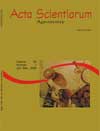<b>Analyses of the behavior of a bimetallic Actinograph (R. Fuess-Brlin-Steglitz) in different types of sky covering</b> - DOI: 10.4025/actasciagron.v26i4.1800
Abstract
Part of the thermodynamic processes that occur in the development of the plants is related to the balance of the solar radiation in the atmosphere. For several years in Brazil, the global solar radiation has been being monitored by actinographs, with some researchers doubting the reliability of these data, comparing the sensor of this instrument, that is constituted by bimetallic plate, with one of the piranometer, elaborated with termopile. In this work, the measures of the global solar radiation are compared, monitored by actinography, and by a piranometer of Kipp and Zonen (I model CM3), instrument of larger precision, in different conditions of sky covering. The data were collected in the Experimental Station Agrometeorologic of the State University of the West of Paraná - Campus of Cascavel (lat. 24º 53`South, long. 53º 23`West, alt. 682m), in the period of January to December, 2001. The found deviations were 18.95% in days of clean sky, 15.78% in days of partially cloudy sky, 4.50% in days of cloudy sky and 15.11% without considering the type of sky covering, showing that the solar irradiation obtained by the actinograph is underestimated independent of the conditions of sky coveringDownloads
Download data is not yet available.
Published
2008-04-11
How to Cite
Dallacort, R., Ricieri, R. P., Silva, S. de L., Freitas, P. S. L. de, & Silva, F. F. da. (2008). <b>Analyses of the behavior of a bimetallic Actinograph (R. Fuess-Brlin-Steglitz) in different types of sky covering</b> - DOI: 10.4025/actasciagron.v26i4.1800. Acta Scientiarum. Agronomy, 26(4), 413-420. https://doi.org/10.4025/actasciagron.v26i4.1800
Issue
Section
Agronomy
DECLARATION OF ORIGINALITY AND COPYRIGHTS
I Declare that current article is original and has not been submitted for publication, in part or in whole, to any other national or international journal.
The copyrights belong exclusively to the authors. Published content is licensed under Creative Commons Attribution 4.0 (CC BY 4.0) guidelines, which allows sharing (copy and distribution of the material in any medium or format) and adaptation (remix, transform, and build upon the material) for any purpose, even commercially, under the terms of attribution.
2.0
2019CiteScore
60th percentile
Powered by 

2.0
2019CiteScore
60th percentile
Powered by 



















































